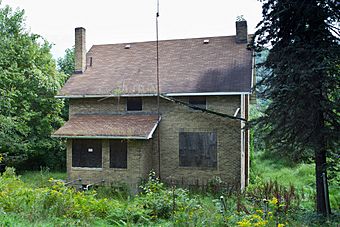Allegheny River Lock and Dam No. 6 facts for kids
Quick facts for kids |
|
|
Allegheny River Lock and Dam No. 6
|
|

Locktenders House, September 2013
|
|
| Location | 1258 River Rd., Bethel Township, Pennsylvania and South Buffalo Township, Pennsylvania |
|---|---|
| Area | 49.6 acres (20.1 ha) |
| Built | 1927-1928 |
| Built by | Dravo Corp.; Corps of Engineers |
| Architectural style | Late 19th And 20th Century Revivals |
| MPS | Allegheny River Navigation System MPS |
| NRHP reference No. | 00000400 |
| Added to NRHP | April 21, 2000 |
The Allegheny River Lock and Dam No. 6 is an important historical structure. It helps boats travel safely on the Allegheny River. This complex includes a lock and a dam. It is located in Armstrong County, Pennsylvania, near Bethel Township and South Buffalo Township.
Contents
Understanding Lock and Dam No. 6
What is a Lock and Dam?
A lock and dam system helps control the water level in a river. This makes it easier for boats to move along the river.
- A dam is like a wall built across a river. It holds back water to create a deeper area, called a pool.
- A lock is like a water elevator for boats. It allows boats to move between different water levels. Boats enter the lock, the water level changes, and then they can exit at the new level.
Building a River Highway
The Allegheny River Lock and Dam No. 6 was built between 1927 and 1928. The United States Army Corps of Engineers oversaw its construction. They worked with the Dravo Corporation to build it. This lock and dam was part of a bigger plan. The goal was to create a system of locks and dams. This system would make the Allegheny River much easier for boats to use. It helped transport goods and people.
Key Parts of the Complex
The Allegheny River Lock and Dam No. 6 complex has several important parts:
- The Lock: This part is 56 feet wide and 360 feet long. It can lift boats by 12.4 feet.
- The Dam: The dam is about 20 feet high and 992 feet long. It helps keep the water at the right level for navigation.
- Operations Building: This building is two stories tall. It was used to control the lock and dam. It has a simple, practical design from the early 1900s.
- Locktenders' Houses: There are two identical houses made of brick. These were homes for the people who operated the lock.
This important structure was recognized for its history. It was added to the National Register of Historic Places in the year 2000.



